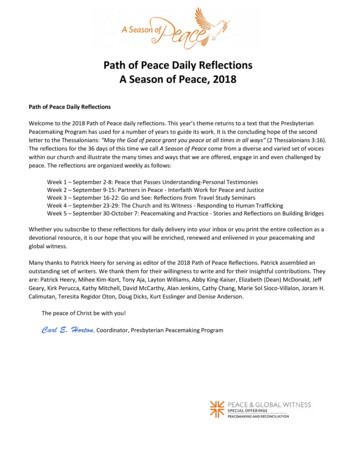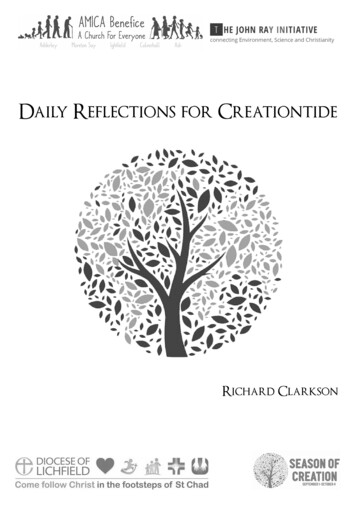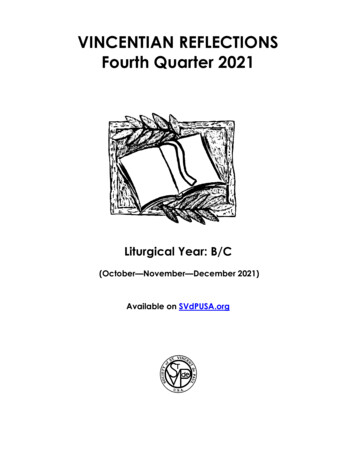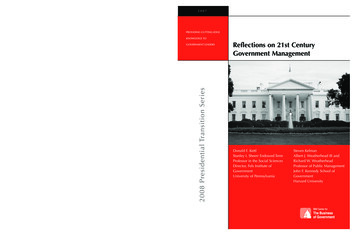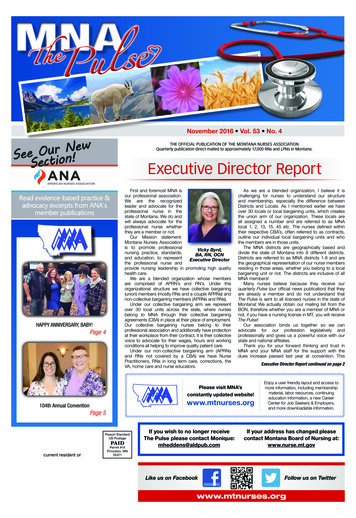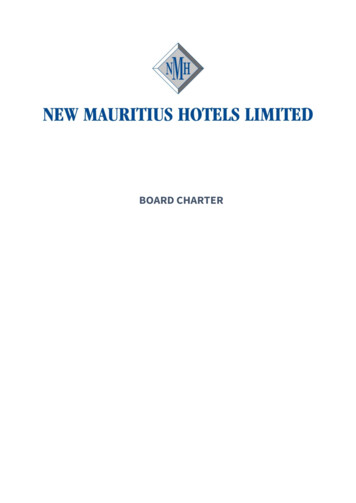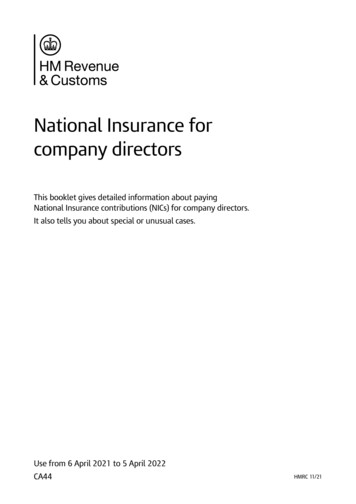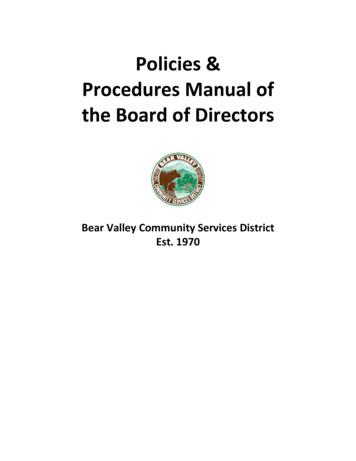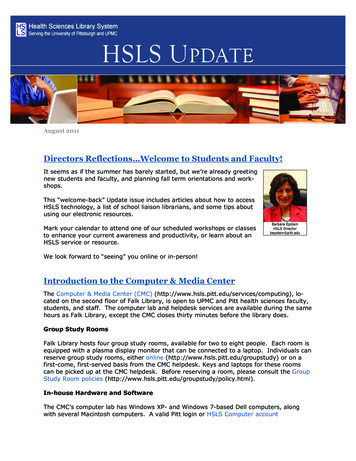
Transcription
August 2011Directors Reflections Welcome to Students and Faculty!It seems as if the summer has barely started, but we’re already greetingnew students and faculty, and planning fall term orientations and workshops.This “welcome-back” Update issue includes articles about how to accessHSLS technology, a list of school liaison librarians, and some tips aboutusing our electronic resources.Mark your calendar to attend one of our scheduled workshops or classesto enhance your current awareness and productivity, or learn about anHSLS service or resource.We look forward to “seeing” you online or in-person!Introduction to the Computer & Media CenterThe Computer & Media Center (CMC) (http://www.hsls.pitt.edu/services/computing), located on the second floor of Falk Library, is open to UPMC and Pitt health sciences faculty,students, and staff. The computer lab and helpdesk services are available during the samehours as Falk Library, except the CMC closes thirty minutes before the library does.Group Study RoomsFalk Library hosts four group study rooms, available for two to eight people. Each room isequipped with a plasma display monitor that can be connected to a laptop. Individuals canreserve group study rooms, either online (http://www.hsls.pitt.edu/groupstudy) or on afirst-come, first-served basis from the CMC helpdesk. Keys and laptops for these roomscan be picked up at the CMC helpdesk. Before reserving a room, please consult the GroupStudy Room policies In-house Hardware and SoftwareThe CMC’s computer lab has Windows XP- and Windows 7-based Dell computers, alongwith several Macintosh computers. A valid Pitt login or HSLS Computer account
(http://www.hsls.pitt.edu/services/account/signup) is needed to connect to the Internet.The computers are equipped with software for word processing, spreadsheets, statistics,graphics, video editing, and database management.Peripheral hardware includes CD-ROM and DVD-ROM writers, video capturing devices, andflat-bed scanners. The CMC also houses two televisions with VHS videotape players andDVD players.PrintingColor, black-and-white, and double-sided printing are available from the CMC. Cash andchange are accepted methods of payment. Medical students can use their subsidized accounts for printing on the black-and-white printer only.Circulating TechnologyThe CMC provides circulating technology, whichcurrently includes Apple iPads, Dell laptops, andone Macintosh iBook that may be checked out bypatrons for up to four hours. Laptops and iPadscan access the Pitt wireless system with a validuniversity username and password, and may betaken outside the library. Also available are headphones that may be checked out for up to fourhours, and USB flash drives that may be checkedout for up to twenty-four hours.The CMC also offers a collection of audiovisual materials including videotapes, CDs, and DVDs whichmay be checked out for one week.Helpdesk ServicesA CMC helpdesk assistant is available to assist with using HSLS technology and services,including Microsoft Office and Adobe software, HSLS Computer Account renewals, remoteaccess, and Pitt wireless. For assistance, stop in at the CMC or call 412-648-9109. Julia JankovicAccess to HSLS E-Resources from HomeAs a Pitt or UPMC affiliated patron, you can access HSLS online books and journals evenwhen you are not on campus or at a UPMC facility. Start by clicking the Remote Accesslink (http://www.hsls.pitt.edu/services/remote) on the upper-right corner of the HSLShome page (http://www.hsls.pitt.edu/). If you are a Pitt user, choose Secure Remote Access, or if you are a UPMC user, choose Connect@UPMC.Pitt – Secure Remote Access Onceon the Secure Remote Access (https://sremote.pitt.edu) page, enter your University Computer Account username and password.
Ifyou are connecting for the first time, you may see a pop-up box asking you to allowJuniper Networks to run. Select Allow. Once connected, select Health Sciences Library Systemfrom the Web bookmarks. You will be redirected to the HSLS home page. You nowhave access to HSLS databases and can view, save, andprint articles from HSLS e-journals. Secure Remote Access is monitored by the Pitt TechnologyHelpdesk: browse the online information /secureremote.html) or call 412-624-4357 for help.UPMC – Connect@UPMC If you are using Connect@UPMC (https://connect.upmc.com) for the first time, you willneed to talk to your UPMC department administrator to set up an account.When your Connect@UPMC account has been set up, you can login with your UPMCNetwork Username.Select Internet Explorer in the set of Applications.From the Favorites menu, select UPMC, and then Health Sciences Library.You will be redirected to the HSLS home page. You now have access to HSLS databases and can view and print articles from HSLS journals.Saving journal articles to your computer’s hard drive can be problematic; try instead tosave to another location, like a flash drive.Connect@UPMC is monitoredby the UPMC ISD helpdesk:browse the online information(http://connect2.upmc.com)or call 412-647-4357 forhelp.Having problems? If you are searching for an article, and you are prompted for a user name and password, either: You didn’t sign in remotely—follow the steps above for Pitt or UPMC. You are trying to access a journal that is not included in the HSLS online collection.If your username and password are invalid: Make sure you are using you Pitt username and password (same as your my.pitt.edulogin) or your UPMC Network username and password. You cannot use your HSLSComputer Account for Remote Access.If you cannot connect to remote access from the above steps: Several browsers and devices currently do not support Remote Access. Check the requirements for Secure Remote Access re-remote-access/Secure VPN Web Mode.pdf) and /connectinfo.htm).You can always contact someone from HSLS for help, either through rian), or by calling the CMC Help Desk at 412-6489109. Questions specific to your Connect@UPMC account should be directed to the UPMCISD helpdesk at 412-647-4357. Julia Jankovic
Liaison Librarians Work in Partnership with Health SciencesSchoolsDo you have a question about how to search a specific database? Feeling overwhelmed andnot sure where to begin researching a topic ofinterest? Ask for help from your school’s liaisonlibrarian.Liaison librarians provide a communication linkbetween HSLS and the departments and programs in the schools of the health sciences. Liaisons can incorporate library and informationmanagement skills into the curriculum, collaborate on research projects or grants, and consultone-on-one on in-depth or specialized topics.Last year the liaison librarians provided instruction and orientations to over 3,000 health sciences students in over 100 class sessions.HSLS Liaison LibrariansDental MedicineRebecca Abromitis, MLSbaa@pitt.edu412-383-8984Graduate School of Public HealthBarbara Folb, MM, MLS, MPHfolb@pitt.edu412-648-1974Health and Rehabilitation SciencesLinda Hartman, MLSlhartman@pitt.edu412-648-1479NursingMary Lou Klem, PhD, MLISklem@pitt.edu412-383-9947PharmacyAhlam Saleh, MD, MLSsaleha@pitt.edu412-648-2166School of MedicineContact the Main Deskmedlibq@pitt.edu412-648-8796 Nancy TanneryHSLS E-Books: STAT!RefSTAT!Ref is one of several e-book platforms to which HSLS provides access. While someplatforms only include e-books from a single publisher, STAT!Ref provides access to ebooks from multiple publishers via a single interface. STAT!Ref currently includes 32 ebooks, as well as ACP PIER, an evidence-based, point-of-care tool.Our subscription includes access to new editions that are automatically updated. STAT!Ref
includes many authoritative titles in medicine and nursing, as well as drug information resources. A few of the most popular e-books include: ACP MedicineACS Surgery: Principles & PracticeAHFS Drug InformationDiagnostic and Statistical Manual of Mental Disorders – 4th Edition (DSM-IV-TR)DrugPoints SystemFundamental & Advanced Nursing SkillsICD-9-CMSparks & Taylor’s Nursing Diagnosis Reference ManualAdditional content provided by STAT!Ref includes: Stedman’s Medical DictionaryMedCalc 3000STAT!Ref Medical News Feed (available with sign-up)STAT!Ref Evidence Alerts (available with sign-up)You can search within the STAT!Ref platform itself. The advanced search option allows youto limit your search to a particular title or group of titles in a specific discipline. Search theentire platform by typing STAT!Ref in the Pitt Resources Quick Search (http://www.hsls.pitt.edu) box or in the PITTCat for the Health Sciences (http://pittcat.hsls.pitt.edu) Search Term(s) box.To access individual e-books: Search for the title in the Pitt Resources Quick Search box (http://www.hsls.pitt.edu) Search for the title in PITTCat for the Health Sciences (http://pittcat.hsls.pitt.edu) Browse HSLS e-books by subject (http://www.hsls.pitt.edu/resources/books/ebooks) Search the full-text of HSLS e-books using the E-Book Full Text search y-meta?v%3aframe form&frontpage 1&v%3aproject laserbeam-ebooks) Jeff HustedTreasures from the Rare Book Room: 27th General Hospital inNew GuineaIn the Forward to the Quarterly History, Volume 1, Lt. Colonel George L. Beatty writes: “Itis our hope that this history may be of some interest, and possibly of some small value toother medical installations in the future.” Beatty’s hope was unfulfilled from 1945 until today, when Falk Library staff have provided detailed information about Beatty’s works andmounted selections on the Web.
The collection is from the 27th General Hospital in New Guinea for which Beatty was thecommanding officer from August 1944 to July 1945. Contained in the collection are twobound volumes of reports, articles, illustrations,charts, graphs, and photographs along with 33glass plate slides. Volume one contains threequarterly reports that describe the activities inthe hospital, including detailed medical reportsthat discuss types and numbers of operations,numbers of patients, incidence of wounds andmortality percentages from them, and detaileddiscussions of treatment for non-surgical patients. Dental and psychiatric services are included. The volume is illustrated with photographs (from the glass slides) and hand-drawnsketches. Volume 2 includes surgical reports, papers written by staff doctors on various medicalprocedures or treatments, and 28 detailed autopsy reports (with patients identified by name).Of special interest to medical historians may be the articles written by staff doctors, a fewof which were also published in medical journals. One unpublished article is “AnestheticProcedures used in a General Hospital in the Communication Zone with Analysis of 2,000Anesthetics” by Captain Leonard M. Monheim of the Dental Corps. In another article, written by Captain Thomas N. Meredith, “Penicillin Therapy at the 27th General Hospital,” theauthor stated: “No fundamentally new concepts were discovered, but penicillin was usedwidely for a great variety of conditions, andconsiderable experience as to its possibilities intopical and local administration was gained.”This unknown article gives further evidence ofthe vital role played by penicillin in World WarII as it became widely used.Library staff does not know how this collectioncame to Falk Library. However, Lt. ColonelJames R. Watson was Chief of Surgical Serviceat the Hospital, and he, Captain Monheim, andCaptain John J. McAleese were affiliated withthe University of Pittsburgh.An online exhibit ebook/wwii) of the collection is available. Further information about the collection can be found in the finding 2.xml). The bound volumes can beviewed in the Rare Book Room by appointment ebook/contact). Leslie CzechowskiNew PubMed Feature: Bolded Search TermsYour PubMed search results now include bolded search terms. This new feature allows youto quickly locate where your search terms appear within each record.
Bolded terms also include terms that have been added by PubMed to enhance your search.For example, a search of cancer translates to include the term neoplasm.This new feature is the default for all users. You still have the option to change your Highlighting Preferences rences.Highlighting Search Terms) in My NCBI.Parts of this article were reprinted from the July-August 2011 NLM Technical /ja11 pm bold.html).So, What Does It Mean to Be a Regional Medical Library?In the June 2011 HSLS Update, we announced that HSLS was awardeda five-year contract from the National Library of Medicine to serve asthe Regional Medical Library (RML) for the National Network of Librariesof Medicine, Middle Atlantic Region (NN/LM-MAR). We have been working diligently to set up our program and recruit qualified staff. Butwhat does it mean to be a regional medical library?Our role is to support the efforts of the National Library of Medicine forthis region to provide all U.S. health professionals with equal access tobiomedical information and improve the public's access to informationso they can make informed decisions about their health.To accomplish this, our collaborative team of librarians will form partnerships with librariesand other organizations, and offer a variety of in-person and online training for health professionals, community organizations, health information centers, and public, hospital andacademic medical libraries throughout Pennsylvania, Delaware, New York and New Jersey.Additionally, we will fund awards to assist regional libraries and information centers to educate and support unaffiliated health professionals and consumers in their local areas.As an RML, our outreach efforts are directed toward libraries, health professionals and consumers. Throughout the five-year contract, our role is to develop, fund and manage a va-
riety of outreach awards, ranging from 2,500- 30,000, that support programs to: Promote the changing role of librarians within their institutions and communities;Provide access to biomedical information to unaffiliated health professionals, includingbehavioral and mental health professionals, the public health workforce, minorityhealth workers and rural, underserved hospitals;Improve health through access to reliable information for consumer groups, includingsoldiers, veterans and their families, senior citizens, caregivers, K-12 schools, community-based and faith-based organizations.Being an RML requires a commitment to continually evaluate the needs of those in our region, and adapt and develop programs to address those needs. It takes a dedicated staffand the support of a strong institution in order to succeed. Stay tuned for future updatesand an introduction to the MAR staff. Renae BargerHealthCAS Cohort-2 Visits PittThe second cohort of students enrolled in Pitt’s online Certificate of Advanced Study inHealth Sciences Librarianship (HealthCAS), visited HSLS and the School of Information Sciences (iSchool) for an orientation to HealthCAS and the University. The students camefrom eight states, including California, Florida, Kentucky, Louisiana, Mississippi, Maryland,Ohio, and Texas.HealthCAS cohort members, faculty, andadministrators came together for a 2.5 dayorientation program. In the cohort model,students share professional experiences,learn from each other, and form a networkof peers to turn to throughout their careers.The onsite visit gives them and the facultythe chance to connect on a more personallevel. This is significant in HealthCAS asstudents are required to collaborate on several online group projects during the year.The HealthCAS orientation included an overview of the program curriculum and objectives,a meeting with instructor teams and an explanation of policy and procedures at Pitt, withan emphasis on academic integrity in writing. In a visit to UPMC Shadyside, studentslearned about Magnet Certification and the role of the medical library in that process. Apresentation by faculty from the Schools of Pharmacy and Medicine introduced students tothe importance of interprofessional education.Though the schedule was full, there was also time for fun. On a beautiful Pittsburgh day,students “quacked” on the Just Ducky Tour, had dinner at the Hard Rock Café at StationSquare, and rode the Monongahela Incline to the top of Mount Washington.HealthCAS is funded by a three-year grant to the iSchool and HSLS from the Institute ofMuseum and Library Services (http://www.imls.gov). The program consists of three semesters of coursework. Each semester covers one four-credit course: (1) Libraries in
Healthcare Environments, (2) Collections and Resources in Healthcare Environments, and(3) Reference Services and Instruction in Healthcare Environments. The three-credit Independent Research Project spans all three semesters. HSLS faculty librarians develop andteach the curriculum.Further information about HealthCAS is available from the iSchool (http://www.ischool.pitt.edu/health) or HSLS (http://www.hsls.pitt.edu/healthcas). Ester SaghafiChanges Coming to the CMCDo you remember Falk Library’s Learning Resource Center (LRC)? The LRC was created in1982 with a donation of audiovisual equipment in memory of Pharmacology Professor PaulL. Mclain. Since then, audiovisual resources have become integral to our users. The modest LRC expanded as new advances in computer-based health care education were increasingly available.As a result of the computer revolution of the late 1980’s, and in order to reflect advancesin computer technology, the LRC evolved into the Microcomputer and Media Center (MMC).The MMC’s small computer lab provided a personal computer experience to the health sciences community. Falk Library’s online catalogue, WordPerfect word processing software,and dot matrix printing attracted patrons by the dozens looking for hand-on experiencewith DOS and Apple systems, as well as the new fangled Windows 1.0.By 1992, the MMC had tripled the number of computers while providing access to MARS,FTP protocols, education software and laser printing. In 1999, the MMC expanded again tobecome the Computer and Media Center (CMC). The name change embodied our commitment to enhance both the computer and media-based technological abilities of the HealthSciences Library System. The Computer and Media Center currently provides up-to-datehardware, software and network connectivity to improve health care education and accessto medical information.To meet the demands of 21st century ubiquitous computing, the computer lab is movingout!In the next several months, our Help Desk, desktop computers, and public printing stationswill be moved out of the CMC and onto the upper floor of the library. We’ll also be increasing the number of circulating tablet and laptop computers. In all, the only thing lost will bethe walls! For those who enjoy the lab-type atmosphere, a classroom setting will be available for patrons when not in use.Stay tuned for further information about dates and details! Fran Yarger
Finding Keepsakes in an Unusual Place!You never know what treasures you’ll find in an old file cabinet!Recently, while cleaning out several old file cabinets in Falk Library, Administrative Specialist Nelson Galloway came across two class rings, a 1971 Sewickley Area High School ringand a 1982 McKeesport High School ring. He also found a 1967 St. Francis School of Nursing pin. Galloway decided to try to locate the owners.Galloway started with the nursing pin which included the engraved initials J.A.K. Through an Internet search, Galloway located Alexis Weber, former director of the St. Francis School ofNursing. She is now director of the UPMC Mercy Hospital Schoolsof Nursing. Weber searched the St. Francis Alumni database andlocated a possible match. She then contacted the nurse. It turnedout the pin did belong to that nurse, who was very excited to hearthe news. She sent Galloway an email stating that she “did loseher pin at Falk and thought that it would never be found.” Galloway mailed the pin to its grateful owner.Some 38 years ago, a young lady lost her high school sweetheart’s Sewickley Area HighSchool ring while attending college at Pitt. Galloway found the ring in one of the file cabinets and called Sewickley Area High School to no avail. Based on the inscription inside thering, he then searched the Internet and local telephone directories and came up with onepossibility. He contacted the man and much to Galloway’s surprise, the man confirmed thatthe ring was his. The man wrote, “it would be very nice to have that ring back to bringback the memories of that period of my life.” Galloway promptly mailed him the ring. Bythe way, that girlfriend is now his wife!There was one ring left, from McKeesport High School. The inscription inside the ring indicated that it belonged to a woman. Galloway contacted the McKeesport Area School District. Using the inscription information, a helpful employee searched the 1982 Commencement Book. There was only one match. Knowing it was very possible the woman had married since graduating from high school; the Alumni Book was also searched. That booklisted the woman’s married name and address. Galloway contacted her and she, too, wasvery surprised and grateful. Incidentally, she currently works at Pitt, so returning the ringwas easy.Through hard work and persistence, Galloway was able to return all of the treasures totheir rightful owners. Jill FoustHSLS Staff NewsThe HSLS Staff News section includes recent HSLS presentations, publications, staffchanges, staff promotions, degrees earned, etc.NewsBarbara Epstein, HSLS director, will chair the Medical Library Association’s Task Force forAdvocating Scholarly Communication.
Michele Klein-Fedyshin, reference librarian, was certified as an ELNEC (End of Life Nursing Education Consortium) Core Trainer.Melissa Ratajeski, reference librarian, was appointed Chapter Council Liaison to theMedical Library Association’s Membership Committee.PresentationsUPMC Shadyside librarians Michelle Burda, Melissa Ratajeski, and Charlie Wessel presented a Web conference talk "Magnet Experience: Providing Services that Facilitate Quality Care, Evidence-Based Practice and Leadership at your Institution" for the Atlanta HealthScience Libraries Consortium meeting on July 14, 2011.PublicationsLeslie Czechowski, assistant director for Access Services, published “Problems with EBooks: Suggestions for Publishers” (http://www.ncbi.nlm.nih.gov/pubmed?term blishers) in JMLA, 99(3):181-2, Jul 2011; “Report on ALA Midwinter Session, ‘Is Selection Dead: The Rise ofCollection Management and the Twilight of Selection’ (http://colldev.mlanet.org/developments/?p 154)” in Developments, 23(1), Spring 2011; and “Providing Access to aHidden Collection at the University of Pittsburgh” (http://www.alhhs.org/watermark.html)in Watermark, 34(3): 60-61, Summer 2011.Barb Folb, public health informationist and reference librarian, Charlie Wessel, head ofHospital Services, and Leslie Czechowski, assistant director for Access Services, published “Clinical and Academic Use of Electronic and Print Books: The Health Sciences Library System E-Book Study at the University of Pittsburgh” 03/pdf/mlab-99-03-218.pdf) in JMLA, 99(3):218-228, Jul 2011.Senior Associate Director Nancy Tannery, along with co-authors Lauren Maggio1, andSteven Kanter2 published “Reproducibility of Literature Search Reporting in Medical Education Reviews” (http://www.ncbi.nlm.nih.gov/pubmed/21694568) in Academic Medicine, 86(8):1049-54, Aug 2011, and “AM Last Page: How to Perform an Effective DatabaseSearch” (http://www.ncbi.nlm.nih.gov/pubmed/21795907) in Academic Medicine, 86(8):1057, Aug 2011.12Lane Medical Library, Stanford University School of Medicine, Stanford, CAUniversity of Pittsburgh School of Medicine, Pittsburgh, PAHSLS Schedule of Classes September—October 2011HSLS offers classes on database searching, software applications such as Adobe Photoshop, bibliographic management, molecular biology and genetics, and library orientations.For more information visit the online course descriptions (http://www.hsls.pitt.edu/class/desc).Classes are held on the first floor of Falk Library (200 Scaife Hall) in Classroom 1 and Conference Room B, and on the second floor in the Computer and Media Center Classroom 2.Some classes are also held in the Conference Room at UPMC Shadyside Libraries. All
classes are open to faculty, staff and students of the schools of the health sciences at theUniversity of Pittsburgh and UPMC.No registration is required for any of these classes. Seating for classes is first-come, firstserved, until the class is full. Classes marked with an asterisk (*) qualify for AmericanMedical Association Category 2 continuing education credit.Class schedules are subject to change. Please consult the online class calendar(http://www.hsls.pitt.edu/calendar) for the most current information.HSLS ORIENTATIONIntroduction to HSLS Resources and Services at Falk Library(Meet inside entrance to Library)Wednesday, September 219-10 a.m.Offered upon request to groups or individuals. Call 412-648-8796.Introduction to HSLS Services at UPMC ShadysideOffered upon request to groups or individuals. Call 412-623-2415.Finding Full-Text Articles at UPMC ShadysideOffered upon request to groups or individuals. Call 412-623-2415.SEARCHING DATABASESPubMed Basics* (Falk Library Classroom 1)Monday, September 121-2:30 p.m.Tuesday, September 2711 a.m.-12:30 p.m.Monday, October 1711 a.m.-12:30 p.m.PubMed for Nurses* (Falk Library Classroom 1)Wednesday, October 121-2:30 p.m.MOLECULAR BIOLOGY AND GENETICS RESOURCESLocating Gene/Protein Information* (Falk Library Classroom 2)Wednesday, September 71-3 p.m.Introduction to Vector NTI* (Falk Library Classroom 2)Wednesday, September 141-3 p.m.Genome Browsers 1* (Falk Library Classroom 2)Tuesday, September 271-3 p.m.Genome Browsers 2* (Falk Library Classroom 2)Wednesday, September 281-3 p.m.SNPs & Genetic Variation* (Falk Library Classroom 2)Wednesday, October 51-3 p.m.
Gene Regulation Resources* (Falk Library Classroom 2)Wednesday, October 121-3 p.m.Pathway Analysis Tools 1* (Falk Library Classroom 2)Wednesday, October 191-3 p.m.Pathway Analysis Tools 2* (Falk Library Classroom 2)Thursday, October 201-3 p.m.Cancer Informatics* (Falk Library Classroom 2)Wednesday, October 261-3 p.m.SOFTWARE TRAININGEndNote Basics(Note: This class is usually full. Please arrive 15 minutes in advance to ensure seating.)Wednesday, September 79:30-11:30 a.m.(Falk Library Classroom 2)Friday, September 91-3 p.m.(Falk Library Classroom 2)Tuesday, October 1110:30 a.m-12:30 p.m.(Falk Library Classroom 2)Thursday, October 2710:30 a.m-12:30 p.m.(Falk Library Classroom 2)Thursday, October 2710 a.m.-noon(UPMC Shadyside Libraries)Adobe Photoshop for Beginners (Falk Library Classroom 2)Thursday, October 139-11 a.m.PowerPoint for BeginnersTuesday, September 13Tuesday, September 209-11 a.m.9-11 a.m.(UPMC Shadyside Libraries)(Falk Library Classroom 2)Advanced PowerPoint for Presentations (Falk Library Classroom 2)Tuesday, October 259-11 a.m.The Wow! Factor: PowerPoint for Posters (Falk Library Classroom 2)Thursday, September 89-11 a.m.Lunch With A LibrarianThese informal, brown-bag lunches are held in Falk Library Conference Room B. Bring yourown lunch. Drinks and dessert are provided. For more information visit the online descriptions .Personal Genomics, Personalized Medicine, and YouMonday, September 8noon-1 p.m.EndNote Clinic (This LWAL is located in Falk Classroom 1)Thursday, October 13noon-1 p.m.
ClassesBack to School Basics (UPMC Shadyside Libraries)Wednesday, September 711:30 a.m.-12:30 p.m.Find it Quick (UPMC Shadyside Libraries)Friday, October 711:30 a.m.-12:30 p.m.Thursday @ Three HSLS UPMC Shadyside Libraries Information SeriesThese informal sessions are held in the Conference Room at UPMC Shadyside Libraries.The Nuts and Bolts of Publishing an Article: Resources and Strategies for AspiringAuthorsThursday, September 223-4 p.m.Registered Research and Clinical Trial DatabasesThursday, October 133-4 p.m.CUSTOMIZED CLASSESCustomized classes uction) can be developed for your department, course, or other group.LEARNING @ YOUR PACEThese online tutorials (http://www.hsls.pitt.edu/services/learning at your pace) provideinformation on getting started at HSLS, focusing on the Web site and popular resources.
When your Connect@UPMC account has been set up, . Schools Do you have a question about how to search a specific database? Feeling overwhelmed and . Nursing Mary Lou Klem, PhD, MLIS klem@pitt.edu 412-383-9947 Pharmacy Ahlam Saleh, MD, MLS saleha@pitt.edu 412-648-2166 School of Medicine
